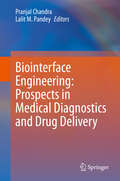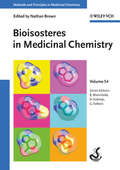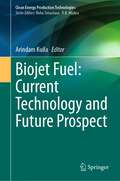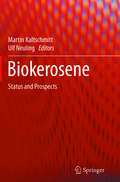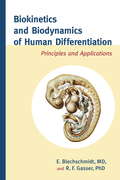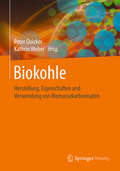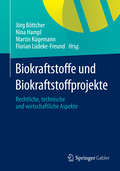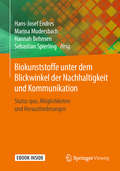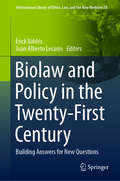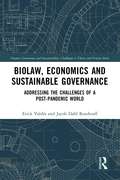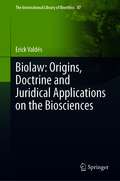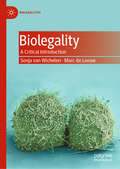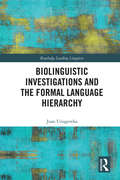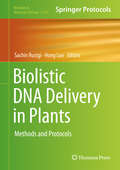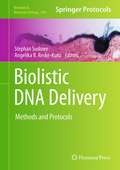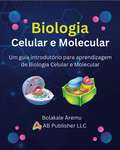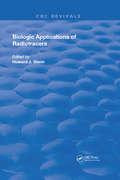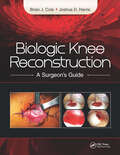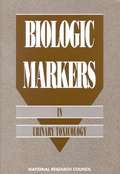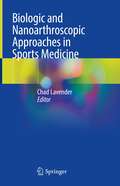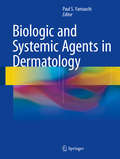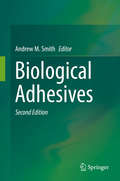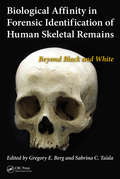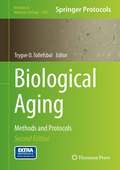- Table View
- List View
Biointerface Engineering: Prospects in Medical Diagnostics and Drug Delivery
by Pranjal Chandra Lalit M. PandeyThis book provides detailed information on the surface and surface chemistry of various biointerfaces for the understanding and development of biosensors, biocompatible devices, and drug delivery systems. It highlights the role of interfacial phenomena towards the behaviour of biomolecules on different surfaces and their significance in recent applications. The book also addresses various surface engineering techniques for the modification of biomaterials that are implemented for improving biocompatibility. It provides an updated scientific concept of various interactions of biological systems with surfaces/modified surfaces at the molecular and cellular level. The chapters include various in-vitro, in-vivo, ex-vivo models to illustrate various aspects of Biointerface Engineering. Finally, the book elucidates troubleshooting strategies and future prospects of Biointerface Engineering in Medical Diagnostics and Drug Delivery.
Bioisosteres in Medicinal Chemistry
by Nathan Brown Raimund Mannhold Gerd Folkers Hugo KubinyiWritten with the practicing medicinal chemist in mind, this is the first modern handbook to systematically address the topic of bioisosterism.As such, it provides a ready reference on the principles and methods of bioisosteric replacement as a key tool in preclinical drug development.The first part provides an overview of bioisosterism, classical bioisosteres and typical molecular interactions that need to be considered,while the second part describes a number of molecular databases as sources of bioisosteric identification and rationalization. The third partcovers the four key methodologies for bioisostere identification and replacement: physicochemical properties, topology, shape, and overlays ofprotein-ligand crystal structures. In the final part, several real-world examples of bioisosterism in drug discovery projects are discussed.With its detailed descriptions of databases, methods and real-life case studies, this is tailor-made for busy industrial researchers with little time for reading, while remaining easily accessible to novice drug developers due to its systematic structure and introductory section.
Biojet Fuel: Current Technology and Future Prospect (Clean Energy Production Technologies)
by Arindam KuilaThis book covers the basic knowledge of biojet fuel, explores the current technological status, and presents future prospects for commercial biojet fuel production. The focus of this book is on biojet fuel production from different types of potential substrates. It also includes technoeconomic analysis and life cycle assessment of biojet fuel. Biojet fuel is currently recognized as the best alternative to petroleum-based jet fuel due to its renewability and sustainable features. However, there is a scarcity of reports on biojet fuel production from various types of substrates.The aviation industry globally consumes approximately 200 million tonnes of jet fuels each year, with a projected continuous growth rate of 5% per year until 2050 (Seymour et al., 2020). Currently, the global demand for jet fuel is predominantly met by petroleum-based fuels. However, the limited availability of fossil fuels and increasing concerns about climate change have placed significant pressure on commercial airlines to reduce greenhouse gas emissions and embrace cleaner and more sustainable practices.Biojet fuel has emerged as the most favorable alternative to petroleum-based jet fuel due to its renewable nature and sustainable characteristics. Despite its potential, there is a limited number of reports available on the production of biojet fuel from different types of substrates. The present scenario of biojet fuel necessitates the development of improved and cost-effective technologies that can yield long-term benefits.The book is useful for students and researchers in various branches of life sciences, including environmental biotechnology, bioprocess engineering, renewable energy, chemical engineering, nanotechnology, biotechnology, microbiology, and more.
Biokerosene: Status and Prospects
by Martin Kaltschmitt Ulf NeulingThe book provides a detailed overview of the biokerosene supply chain. It describes the current market situation for aviation fuels and their demands, which will continue to increase during the coming years. On the other hand, the available resources of fossil fuel energy are limited. In order to solve these problems new ways to produce biokerosene have been discussed. So the authors give an in-depth description of classical and new non-edible biomass feedstock. For a broad variety of possible feedstock materials, the state of the art of biokerosene production is discussed taking into account the fuel standards which have to be fulfilled. Experiences from different long-term test flights are presented, and an overall assessment of the currently available conversion pathways from biomass to biokerosene are given.
Biokinetics and Biodynamics of Human Differentiation
by R. F. Gasser E. BlechschmidtFifty years ago the field of human embryology was incomplete; prior to that time the anatomy of early human embryos was still unknown, and there was much to be learned about the older stages of human embryonic development. It is now understood that human organs result from step-by-step differentiations of the growing human embryo. Research by renowned embryologist Erich Blechschmidt, MD, showed that differentiations are not only the result of a gene effect, but are also brought about through growth initiated by extragenetic (occurring outside the gene) information. Without this extragenetic information the differentiation would not begin. Dr. Blechschmidt and coauthor Raymond Gasser, PhD, maintain that Haeckel's biogenetic law (ontogeny recapitulates phylogeny) was an erroneous attempt to explain developmental processes. Blechschmidt's human embryological investigations showed that Darwin's principles (mutation and selection) are likely valid for the origin of the species, but that they cannot explain the ontogenesis of the organs. The ontogenesis of each individual cannot be derived from phylogenetic facts. The authors stress that a clear distinction must be made between the vast field of phylogenetics and the much more exact and understandable field of ontogenetics--particularly the process of differentiation--and their goal is to present not only the abstract biokinetic principles of differentiation, but the originality of embryonic human beings as well. Their knowledge of developmental movements leads to their conclusion that differentiation is an undivided biodynamic process that occurs during development and includes the chemical processes as well. Logically organized into two sections (the first covers early metabolic fields and includes chapters on the one-cell human ovum, the early embryo, blood vessels, the nervous system, head region, trunk, and limbs; the second describes metabolic fields in later developmental stages, distinguishing fields of corrosion, densation, contusion, distusion, retention, dilation, liquation, and detraction), Biokinetics and Biodynamics of Human Differentiation warrants reading by thoughtful professionals in a number of fields concerned with embryonic differentiation. A new preface by Dr. Gasser addresses how the book's principles and findings were and are understood in the field of human embryology.
Biokohle: Herstellung, Eigenschaften und Verwendung von Biomassekarbonisaten
by Andrea Kruse Peter Quicker Kathrin Weber Dennis Blöhse Thomas Echterhof Sabrina Eichenauer Simone Heger Claudia Kammann Marc-André Schulten Christoph Sager Saulo Seabra Klaus Serfass Ernst StadlbauerBiomassekarbonisate (Biokohlen) besitzen signifikant unterschiedliche Eigenschaften, die von den Herstellungsverfahren, Prozessbedingungen und Ausgangssubstraten abhängen. Im Buch sind die technisch verfügbaren Verfahren zur Erzeugung von Biokohle beschrieben und die thermochemischen Prozesse erörtert. Anhand von zahlreichen farbigen Abbildungen sind die Prozesse, Eigenschaften und Einsatzmöglichkeiten veranschaulicht. Der Fokus des Buches liegt auf den großtechnischen Anwendungen als Energieträger, als Reduktions- oder Aufkohlungsmittel in metallurgischen Verfahren, in Recyclingprozessen oder in Kraft- und Zementwerken. Aber auch die Anwendung von Biomassekarbonisaten in der Landwirtschaft als Bodenhilfsstoff oder in der Tierhaltung ist aufgezeigt.
Biokraftstoffe und Biokraftstoffprojekte: Rechtliche, technische und wirtschaftliche Aspekte
by Jörg Böttcher Nina Hampl Martin Kügemann Florian Lüdeke-FreundDieses Buch beschäftigt sich mit Biokraftstoffen und Biokraftstoffprojekten. Die Autoren zeigen auf, welche rechtlichen, agrarischen, ökologischen und ökonomischen Rahmenbedingungen von Biokraftstoffen beachtet werden müssen. Die Betrachtung dieser Rahmenbedingungen und weiterer - eher anlagenbezogener - Faktoren ermöglicht es dann, Rückschlüsse auf die Realisierung von Biokraftstoffvorhaben zu ziehen. Besonderes Augenmerk wird dabei auf den sensiblen Themenkomplex der Nachhaltigkeit von Biokraftstoffen gerichtet. Die anhaltende Diskussion unerwünschter sozialer, ökologischer und ökonomischer Effekte hat zu neuen und bislang nicht abschließend definierten gesellschaftlichen und politischen Ansprüchen an die Biokraftstoffindustrie geführt.
Biokunststoffe unter dem Blickwinkel der Nachhaltigkeit und Kommunikation: Status quo, Möglichkeiten und Herausforderungen
by Hans-Josef Endres Marina Mudersbach Hannah Behnsen Sebastian SpierlingDas Buch zeigt, wie eine Nachhaltigkeitsbewertung von Biokunststoffen gelingen kann und wie die Ergebnisse einer solchen Bewertung ausfallen. Es analysiert die öffentliche Wahrnehmung beim Verbraucher sowie die politischen Rahmenbedingungen von Biokunststoffen.
Biolaw and Policy in the Twenty-First Century
by Erick Valdés Juan Alberto LecarosThis book offers an impressive collection of contributions on the epistemology of international biolaw and its applications, both in the legal and ethical fields. Bringing together works by some of the world’s most prominent experts on biolaw and bioethics, it constitutes a paradigmatic text in its field. In addition to exploring various ideologies and philosophies, including European, American and Mediterranean biolaw traditions, it addresses controversial topics straight from today’s headlines, such as genetic editing, the dual-use dilemma, and neurocognitive enhancement. The book encourages readers to think objectively and impartially in order to resolve the ethical and juridical dilemmas that stem from biotechnological empowerment and biomedical techniques. Accordingly, it offers a valuable resource for courses on biolaw, law, bioethics, and biomedical research, as well as courses that discuss law and the biosciences at different professional levels, e.g. in the courts, biomedical industry, pharmacological companies and the public space in general.
Biolaw, Economics and Sustainable Governance: Addressing the Challenges of a Post-Pandemic World (Finance, Governance and Sustainability)
by Erick Valdés Jacob Dahl RendtorffThis book offers an accurate and updated approach to the main contributions of cosmopolitan biolaw in relation to sustainability, global governance, organizational health care economics and COVID-19. Bringing together different robust and dense biojuridical epistemologies to analyze key bioethical problems as well as the health care, management, economics and sustainability issues of our time, it constitutes a paradigmatic text in its field. In addition to exploring different epistemologies and jurisdictional scopes of biolaw, including the relationships between this new field and the challenges which have arisen in the current globalized and technologized world, the book addresses controversial issues straight from today’s headlines: for example, the basics for health care, finance and organizational economics, global biojuridical principles for governance, globalization, bioscientific empowerment, global and existential risk and sustainability challenges for a post-pandemic world. The book encourages readers to think impartially in order to know and understand the bioethical and biojuridical dilemmas that stem from current economics and sustainability issues. Accordingly, it will be a valuable resource for courses in the fields of biolaw, law, bioethics, global sustainability, organizational health care economics, and global governance at different professional levels.
Biolaw: Origins, Doctrine and Juridical Applications on the Biosciences (The International Library of Bioethics #87)
by Erick ValdésThis book configures a consistent epistemology of biolaw that distinguishes itself from bioethics and from a mere set of international instruments on the regulation of biomedical practices. Such orthodox intellection has prevented biolaw from being understood as a new branch of law with legally binding force, which has certainly dwindled its epistemological density. Hence, this is a revolutionary book as it seeks to deconstruct the history of biolaw and its oblique epistemologies, which means not accepting perennial axioms, and not seeing paradigms where only anachronism and anomaly still exist. It is a book aimed at validity, but also at solidity because the truth of biolaw has never been told before. In that sense, it is also a revealing text. The book shapes biolaw as an independent and compelling branch of law, with a legally binding scope, which boosts the effectiveness of new deliberative models for legal sciences, as well as it utterly reinforces hermeneutical and epistemological approaches, in tune with the complexity of disturbing legal scenarios created by biomedical sciences’ latest applications. This work adeptly addresses the origins of the European biolaw and its connections with American bioethics. It also analyses different biolaw’s epistemologies historically developed both in Europe and in the United States, to finally offer a new conception of biolaw as a new branch of law, by exploring its theoretical and practical atmospheres to avoid muddle and uncertainty when applied in biomedical settings. This book is suitable for academics and students of biolaw, law, bioethics, and biomedical research, as well as for professionals in higher education institutions, courts, the biomedical industry, and pharmacological companies.
Biolegality: A Critical Introduction (Biolegalities)
by Marc de Leeuw Sonja van WichelenThis book provides a comprehensive analysis of the empirical and theoretical problems posed by the encounter between law and biology in the twenty-first century. How does biotechnology and new bioscientific knowledge affect our legal institutions, our sense of justice, and our ways of relating to one another? To answer these questions, authors Marc de Leeuw and Sonja van Wichelen examine the complex and often contested ways in which biotechnology and biological knowledge are reworked by, with, and against legal knowledge. As this book shows, recent developments in the life sciences—including molecular biology, immunology, and the neurosciences—and their applications in forensics, medicine, and agriculture test longstanding legal forms, such as property, personhood, parenthood, and (collective) identity, ultimately constituting the current field of “biolegality.” The authors argue that these biolegal contestations represent philosophical and anthropological challenges to existing understandings of exchange, self, kinship, and community. By addressing how biology and law inform new ways of relating and knowing, the book proposes a programmatic intervention, asserting the pivotal role the study of biolegality plays in advancing social and political theory.
Biolinguistic Investigations and the Formal Language Hierarchy (Routledge Leading Linguists)
by Juan UriagerekaThis volume collects some of Juan Uriagereka’s previously published pieces and presentations on biolinguistics in recent years in one comprehensive volume. The book’s introduction lays the foundation for the field of biolinguistics, which looks to integrate concepts from the natural sciences in the analysis of natural language, situating the discussion within the minimalist framework. The volume then highlights eight of the author’s key papers from the literature, some co-authored, representative of both the architectural and evolutionary considerations to be taken into account within biolinguistic research. The book culminates in a final chapter showcasing the body of work being done on biolinguistics within the research program at the University of Maryland and their implications for interdisciplinary research and future directions for the field. This volume is essential reading for students and scholars interested in the interface between language and the natural sciences, including linguistics, syntax, biology, archaeology, and anthropology.
Biolistic DNA Delivery in Plants: Methods And Protocols (Methods In Molecular Biology Ser. #2124)
by Hong Luo Sachin RustgiThis volume details protocols for the use of the biolistic DNA delivery method in different plant species. Chapters guide readers through non-protocol chapters that cover relevant topics of interest, a broad overview of the field, exciting modifications of the system, and reliable plant transformation procedures in different plant species. Written in the highly successful Methods in Molecular Biology series format, chapters include introductions to their respective topics, lists of the necessary materials and reagents, step-by-step, readily reproducible laboratory protocols, and tips on troubleshooting and avoiding known pitfalls. Authoritative and cutting-edge, Biolistic DNA Delivery: Methods and Protocols aims to provide a comprehensive collection of protocols to intended to be a practical guide for the novice as well as the advanced user in the field of plant genetic transformation.
Biolistic DNA Delivery: Methods and Protocols (Methods in Molecular Biology #940)
by Angelika B. Reske-Kunz Stephan SudoweBiolistic transfection represents a direct physical gene transfer approach in which nucleic acids are precipitated on biologically inert high-density microparticles (usually gold or tungsten) and delivered directly through cell walls and/or membranes into the nucleus of target cells by high-velocity acceleration using a ballistic device such as the gene gun. Biolistic DNA Delivery: Methods and Protocols provides a comprehensive collection of detailed protocols intended to provide the definitive practical guide for the novice as well as for the advanced gene transfer expert on how to introduce nucleic acids into eukaryotic cells using the biolistic technique. Split into six convenient sections, this detailed volume covers biolistic gene transfer into plants, nematodes, and mammalian cells, both in vitro and in vivo, as well as the use of gene gun-mediated DNA vaccination in various experimental animal models of human diseases, and the description of biolistic delivery of molecules other than nucleic acids. Written in the highly successful Methods in Molecular BiologyTM series format, chapters include introductions to their respective topics, lists of the necessary materials and reagents, step-by-step, readily reproducible laboratory protocols, and tips on troubleshooting and avoiding known pitfalls. All-inclusive and cutting-edge, Biolistic DNA Delivery: Methods and Protocols brings together the knowledge and the experience of leading experts in the field of gene transfer in order to serve all researchers who wish to further our abilities in this vital field.
Biologia Celular e Molecular: Um guia introdutório para aprendizagem de Biologia Celular e Molecular
by Bolakale AremuEste livro foi elaborado para estudantes que desejam aprender e apreciar tópicos biológicos básicos enquanto estudam as menores unidades da biologia: moléculas e células. A biologia molecular e celular é uma disciplina dinâmica. Existem milhares de oportunidades nas áreas médica, farmacêutica, agrícola e industrial. Além de prepará-lo para uma diversidade de planos de carreira, a compreensão da biologia molecular e celular o ajudará a tomar decisões acertadas que podem beneficiar sua dieta e saúde. Nossos escritores, colaboradores e editores são altamente qualificados em ciências e humanidades, com ampla experiência em ensino e pesquisa em sala de aula. Eles são especialistas na preparação de alunos para testes padronizados, bem como em treinamento de admissão em graduação e pós-graduação. Dê uma olhada no índice: Capítulo 1. Por que estudar biologia celular e molecular? Capítulo 2: O Estudo da Evolução Capítulo 3: O que é Biologia Celular? Capítulo 4: Genética e nossos projetos genéticos Capítulo 5: Conhecendo os Átomos Capítulo 6. Como as ligações químicas combinam átomos Capítulo 7: Água, Soluções e Misturas Capítulo 8 : Quais elementos estão nas células? Capítulo 9: Macromoléculas são as “grandes” moléculas dos seres vivos Capítulo 10: Termodinâmica em Coisas Vivas Capítulo 11: ATP como “Combustível” Capítulo 12: Metabolismo e Enzimas na Célula Capítulo 13: A diferença entre células procarióticas e eucarióticas Capítulo 14: A Estrutura de uma Célula Eucariótica Capítulo 15: A Membrana Plasmática: O Guardião da Célula Capítulo 16: Difusão e Osmose Capítulo 17: Transporte Passivo e Ativo Capítulo 18: Transporte em massa de moléculas através de uma membrana Capítulo 19: Sinalização Celular Capítulo 20: Oxi
Biologic Applications of Radiotracers (Routledge Revivals)
by Howard J. GlennFirst published in 1982: This present volume presents an excellent amount of animal Models in radiotracer investigations, describes the animal radiopharmacology laboratory, and discusses radiotracer distribution differences between species.
Biologic Knee Reconstruction: A Surgeon's Guide
by Joshua Harris Brian ColeTreatment of articular cartilage pathology in the knees of young and active patients is a challenging and controversial issue. Biologic Knee Reconstruction: A Surgeon's Guide is a how-to, step-by-step guide that addresses the evaluation and management of this unique patient population. Internationally renowned cartilage experts Dr. Brian J. Cole and Dr. Joshua D. Harris, along with their contributors, present information on normal and abnormal history and physical examination. The reader will learn proper decision-making using a patient-centered approach of treatment, increasing the likelihood of a successful outcome. In addition to radiographic assessment of articular cartilage, Biologic Knee Reconstruction discusses the use of biomarkers, defect classification, and patient-reported and surgeon-measured outcomes. Aggressive nonsurgical medical management, including medications, injections, physiotherapy, and rehabilitation, is also presented.Biologic Knee Reconstruction also discusses the management of concomitant pathologies such as malalignment, meniscal deficiency, and ligamentous instability. Selection of surgical cartilage restorative treatment options is multifactorial, requiring consideration of several patient-, knee-, and defect-specific issues. All contemporary open and arthroscopic cartilage techniques are presented in detail with high resolution figures. A unique feature of Biologic Knee Reconstruction is the presentation of several chapters discussing non-medical issues highly pertinent to the advancement and future of this field: funding of research and cost of new advanced technologies, regulation of advanced cellular, tissue, and genetic technologies, evidence-based medicine and clinical trial design and conduct, and the ethics of allograft tissues and stem cell use.Features: Technique preference cards from the experts performing cartilage surgery Patient education information The most up-to-date descriptions of advanced cartilage techniques Unique chapters not covered in books elsewhere, including: Biomarkers Patient-reported outcomes assessment Newer injection techniques (PRP, stem cells) One- and two-stage open and arthroscopic techniques using chondrocyte- and stem cell based cell therapies Costs and public and private funding of research Barriers to high-quality randomized trials Governmental regulation and availability/accessibility to patients Gene therapy and tissue engineering Ethics of articular cartilage surgery with stem cells, ex-vivo cell manipulation, and juvenile tissue sources With the most up-to-date content and step-by-step methods for surgical procedures, Biologic Knee Reconstruction: A Surgeon's Guide is the perfect addition to the bookshelf of the orthopedic surgeon, cartilage researcher, sports physical therapist, or athletic trainer who evaluates and manages this unique patient population.
Biologic Markers in Urinary Toxicology
by Subcommittee on Biologic Markers in Urinary ToxicologyDiseases of the kidney, bladder, and prostate exact an enormous human and economic toll on the population of the United States. This book examines prevention of these diseases through the development of reliable markers of susceptibility, exposure, and effect and the promise that new technologies in molecular biology and sophisticated understanding of metabolic pathways, along with classical approaches to the study of nephrotoxicants and carcinogens, can be developed and prevention of the diseases achieved. The specific recommendations included in this book complement those made in the previous three volumes on biomarkers, Biologic Markers in Reproductive Toxicology (1989), Biologic Markers in Pulmonary Toxicology (1989), and Biologic Markers in Immunotoxicology (1991).
Biologic Therapy for Psoriasis: Cutting Edge Treatment Principles (Updates in Clinical Dermatology)
by Tina Bhutani Wilson Liao Nicholas BrownstoneBiologic therapy is a treatment that strives to modulate a patient's immune system to fight a given disease. In psoriasis, a skin disorder that is partly caused by a dysregulated immune system resulting in well-demarcated red areas of the skin with white scales, biologic therapy has the potential to vastly improve upon patient outcomes by minimizing the symptoms of this disease while maximizing the safety profile of the therapy. This book offers an up-to-date and comprehensive review on biologic therapy for the treatment of psoriasis. With over 10 FDA approved biologic agents for psoriasis (with more in the pipeline), confusion exists among providers regarding which agent is best for a particular patient. Chapters cover all FDA approved psoriasis biologic agents (including pipeline agents) for use in pediatric, adult, and geriatric patients. This book is unique in that it will not only cover cutting edge treatment principles based on the latest research, it will also be one of the most comprehensive reviews of psoriasis biologics in the COVID-19 era. Biologic Therapy for Psoriasis is a must-have resource for board certified dermatologists and rheumatologists, dermatology and rheumatology residents and fellows, dermatology physician assistants, nurse practitioners and medical students. The ultimate goal of this book is to improve patient care by making the busy practicing dermatology provider more adept with these particular therapies.
Biologic and Nanoarthroscopic Approaches in Sports Medicine
by Chad LavenderIn recent years, there have been a number of exciting advances in biologic and nanoarthroscopic approaches in sports medicine, giving the clinician even more options for safe and effective minimally invasive treatments for the active patient. This practical text presents these breakthrough techniques in detail and describes the authors' experiences and lessons learned.This book is broken into two main sections. The first section presents the history of the use of biologics in sports medicine and will have several chapters describing novel techniques using platelet-rich plasma (PRP) and bone marrow concentrate (BMC), all-inside allograft ACL reconstruction, minimally invasive quad tendon harvest with endoscopic closure, and cartilage transfer (ACT) using an autologous tissue collector, among others. The second section describes the history of arthroscopy and the most recent use of nanoarthroscopy, including several novel techniques utilizing the nanoscope, such as incisionless partial medial meniscectomy, synovectomy of the knee, and single incision approaches for the anterior labrum and rotator cuff.Practical and cutting edge, Biologic and Nanoarthroscopic Approaches in Sports Medicine is an exciting exploration of the most recent management approaches for both sports medicine and orthopedic surgeons.
Biologic and Systemic Agents in Dermatology
by Paul S. YamauchiWritten by leading experts in the field and designed for dermatologists and residents, this book includes evidence-based medicine that underscores the clinical data, as well as practical tips on how to use both biologic and systemic agents in the field of dermatology. In the past decade, there have been several groundbreaking advances in medical dermatology. Novel biologic and systemic agents have been developed to treat inflammatory disorders, including psoriasis and atopic dermatitis, as well as skin malignancies such as melanoma. Biologic and Systemic Agents in Dermatology encompasses these developments by describing the mechanism of action of these various agents and the clinical efficacy and safety to treating these respective disorders. The utilization of biologic and systemic agents in other dermatologic conditions, pharmacoeconomics, pharmacovigilance, and clinical trials outcomes are discussed as well as topics including tumor necrosis, conventional systemic agents for psoriatic disease, and oral agents for atopic dermatitis.
Biological Adhesives
by Andrew M. SmithMany creatures use adhesive polymers and structures to attach to inert substrates, to each other, or to other organisms. This is the first major review that brings together research on many of the well-known biological adhesives dealing with bacteria, fungi, algae, and marine and terrestrial animals. As we learn more about their molecular and mechanical properties we begin to understand why they adhere so well and with this comes broad applications in areas such as medicine, dentistry, and biotechnology.
Biological Affinity in Forensic Identification of Human Skeletal Remains: Beyond Black and White
by Gregory E. Berg Sabrina C. Ta’alaAncestry determination in the identification of unknown remains can be a challenge for forensic scientists and anthropologists, especially when the remains available for testing are limited. There are various techniques for the assessment of ancestry, ranging from traditional to new microbiological and computer-assisted methods. Biological Affinity
Biological Aging: Methods and Protocols (Methods in Molecular Biology #1048)
by Trygve O. TollefsbolThe second edition of Biological Aging: Methods and Protocols expands upon the previous edition with current, detailed, useful and promising methods currently available to study aging. With new chapters on protocols that detail aging cell culture as well as many more contemporary approaches such as nuclear transfer, microarray and proteomics technologies. Written in the highly successful Methods in Molecular Biology series format, chapters include introductions to their respective topics, lists of the necessary materials and reagents, step-by-step, readily reproducible laboratory protocols, and key tips on troubleshooting and avoiding known pitfalls. Authoritative and practical, Biological Aging: Methods and Protocols, Second Edition details the most recent breakthroughs in technology that have served to advance the study of aging.
